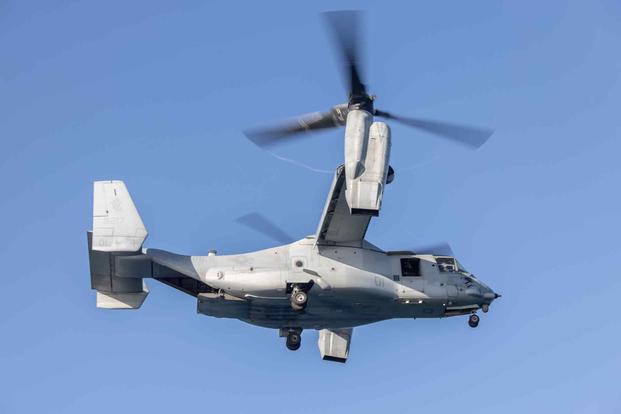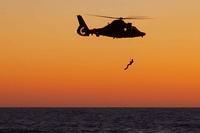After a report revealing a deadly Osprey crash that claimed the lives of five Marines was caused by a persistent clutch issue -- a problem the Marine Corps knew about for years -- the wife of one of the pilots is questioning the service's claims of a near-perfect fix.
"How could they have a model that says this one part will fix it in 99%?" Amber Sax, the wife of Capt. John Sax, a pilot who died on the Marine Corps Osprey when it crashed into the southern California desert on June 8, 2022, asked Military.com. "How are they even mathematically certain about that?"
Amber Sax is not alone in her skepticism. Aviation experts who spoke to Military.com raised similar questions over what appears to be an extraordinary claim about the safety of the primary assault support aircraft for the Marine Corps, as well as an aircraft used by the Air Force and Navy.
But the program manager of the V-22 program, Col. Brian Taylor, defended the model in an exclusive interview and said that, while officials can't identify why hard clutch engagements are happening, he's confident in the research the military has done to mitigate future incidents.
The fix Sax is referring to is a part swap aimed at stopping a hard clutch engagement, often referred to as HCE. It's an issue with the Osprey's complex web of clutches and linkages that, when encountered, shreds the components responsible for powering the aircraft's propellers.
The Marine Corps revealed last August that the issue has plagued the Osprey platform for years, with 15 mishaps.
The five Marines who took off on a training flight June 8, 2022, died when their Osprey suffered a catastrophic clutch issue, the Marine Corps revealed in an investigation report last week. They were the first known casualties of a hard clutch engagement. According to the documents included in the report on the crash, the crew was among the best the Corps had to offer.
The part being replaced is known as the input quill assembly. The news of the part replacement was first announced in February, but last week's release of the investigation into the downing of Swift 11 -- the call sign for the Osprey that crashed in June 2022 -- revealed that HCE likely happens after 800 hours of flight.
But what is actually causing the hard clutch engagements to occur remains elusive for military officials, though they've claimed to have identified some potential issues.
Despite no clear understanding of what causes the problem, the office that runs the Osprey program for the Pentagon claimed in a statement released last week that, "through a combination of efforts, including the recent input quill assembly replacement bulletin in February 2023, the risk of a HCE event occurring was reduced by greater than 99%."
Amber Sax, who has a graduate degree in analytics, said she questioned the Marine Corps about the figure at the briefing held for the families last week ahead of the report's public release.
"They told me they didn't have the exact model figures or details in front of them," she said. "You'd think if they were releasing that level of optimism to the press, they'd want to share that with the families."
Aviation experts, such as Ron Alvarado, a retired Marine Corps aviator and consultant with Aero Consulting Experts, told Military.com that the claim of a fix, while still not having identified the underlying problem, raises questions. He chalks it up to being another problem with an aircraft that's had a tumultuous time in service.
"It sounds like it's either semantics or they just used the wrong language," Alvarado told Military.com. "This has always been a very controversial aircraft, and this does not surprise me that a problem like this is occurring."
Taylor, the head of the office that manages the V-22 Osprey aircraft for the Marine Corps, Air Force and Navy, said that much of the military's confidence in the effectiveness of the replacement part comes from an uptick in HCE incidents in the fall of 2022.
"Once we had added the additional data points that we gathered last fall, we really got a good indication in this Weibull model that we're looking at a 'wear-out mode,'" he said, referring to the wearing out of the input quills, during a phone interview Thursday.
Taylor said the Weibull is a mathematical model that is "a statistically recognized industry standard for mechanical systems." The Weibull distribution model is a probability distribution used to determine failure rates.
"Once we had the data to substantiate that, we moved very quickly on the implementation of the life limit," Taylor said, referring to the amount of estimated time before the input quills begin to malfunction.
However, all of the data Taylor referenced was from 16 incidents -- 15 of which have already been publicly disclosed. It’s not clear how, from those 16 incidents, the Marine Corps came to its 99% risk mitigation calculation.
Sax said she asked Marine Corps officials how many additional clutch mishaps happened between August and February to perfect the model.
"They wouldn't answer me," she said.
Marine leaders quoted in the July 21 crash report and Taylor both acknowledged that the true cause of the issue remains unknown.
"We have a good understanding of what happens and where it happens, and it happens inside of the input quill," Taylor said. "The piece that we're missing, really, is just the initiating events ... that's the part that we're continuing to look for."
Taylor said that they continue to follow the data and are still working to get to the bottom of the issue.
"I will tell you that all of these hard clutch engagement events have been a call to action for me and this entire program team to better understand this particular issue," Taylor said. "This is a process, and this process is ongoing at Naval Air Systems Command to ensure all of our systems are as safe as possible."
Alvarado, adding to Taylor's observation, told Military.com that the services can't stop flying the V-22. The aircraft are needed for missions, so it's clear efforts have to be focused on risk mitigation, even if the overarching problem has not yet been identified.
"Nobody wants to lose Marines, nobody wants to lose airmen," Alvarado told Military.com. "In order for these to fly, they've got to do some type of risk management and risk assessments. ... They want to keep them flying, keep them safe and keep the Marine safe, but at the same time they can't keep these things on the ground."
Meanwhile, Sax still has serious doubts about what the 99% figure really means.
"I think they got to the bottom of the input quill degradation but not HCE," she said. "It's likely not just a single part failure, but a combination of many things."
Air Force Special Operations Command, which also flies the Osprey, told Military.com that it is "confident in the mitigation measures put in place and CV-22s remain ready and able to support operations around the globe as needed."
Notably, last August, AFSOC made a decision -- independent of the Marine Corps -- to ground its Ospreys as the hard clutch engagement issue was being investigated. The day after the Air Force's stand-down, the Marine Corps said it would continue to fly the aircraft.
But now, when asked by Military.com whether it would again consider standing down aircraft like a year ago, AFSOC spokeswoman Lt. Col. Rebecca Heyse said the command is committed to "following the data" and will coordinate with the Joint Program Office.
Heyse told Military.com that they are taking steps to alleviate any concerns airmen have over the platform.
"In coordination with the JPO, we conducted town halls with all CV-22 aircrew this week to inform them of the results of the USMC investigation and answer any questions they had about the ongoing efforts to identify the cause of HCE," Heyse said.
Meanwhile, Japan, which began flying the aircraft in 2020, grounded its fleet of 14 Ospreys a day after the crash report was released, Stars and Stripes reported. The country, which is the first outside the U.S. to fly the aircraft, also grounded its fleet after the Air Force did so back in August 2022.
Sax and other families of the Swift 11 crash victims now say they want answers, but that desire is tempered by the understanding of the crucial role the Osprey plays for the Corps.
"John loved being a Marine, and he loved flying the Osprey. If he were with us today, he would still be flying them. The Marine, aviation and Osprey communities became our second families throughout our marriage," Sax said. "My quest for more information is fueled by the earnest desire to safeguard that family."
Kelsie Hancock, a reservist Marine and fiancee of pilot Capt. Nicholas Losapio, who died in the Swift 11 crash, said in a recent Instagram post that she loves the Osprey but that she's "determined to fight with everything I've got to make sure we don't have another mishap like we did on June 8, 2022."
Sax has also hired an aviation attorney, Timothy Loranger, and his team to look into the clutch issue and the crash of Swift 11.
"Loranger and his team ... are combing over the military's report to try to find additional answers, including reviewing past hard clutch engagement investigations," she said.
She said she hopes that will apply pressure to developer Bell-Boeing and the manufacturers to find the root cause -- and some answers.
"This type of unrecoverable, catastrophic failure can't happen again," Sax said.
-- Konstantin Toropin can be reached at konstantin.toropin@military.com. Follow him on Twitter @ktoropin.
-- Thomas Novelly can be reached at thomas.novelly@military.com. Follow him on Twitter @TomNovelly.
Related: A Mysterious Osprey Clutch Issue Caused the Deaths of 5 Marines. But V-22s Remain Flying.














